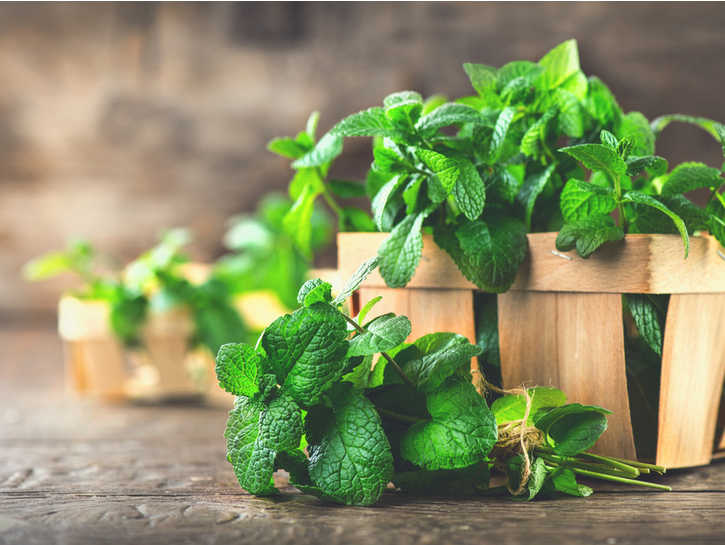Adding fresh herbs to food supplies savory flavor and zest, making any meal a delicious experience for the taste buds. Whether you prefer to spice things up with some thyme, sage, or a little bit of chive, there is one herb that has an extremely distinct flavor profile and provides more health benefits than you could imagine: mint.
What Is Mint?
Known for its fresh, strong taste, mint is one of the most popular flavors found in everyday products, from toothpaste to chewing gum. Around 20 species of the herb exist, and spearmint is most commonly used in cooking. The plant is easy to grow, produces a pleasant scent and adds a delicious refreshing flavor to many dishes and drinks.

anastasiia agafonova/Shutterstock
Why Use Mint?
Mint leaves have a lot more to offer than combating bad breath, and the ways mint leaves can improve your health may come as a refreshing surprise. Mint can help soothe stomach aches and provide relief from Irritable Bowel Syndrome, act as an anti-inflammatory, boost your immune system and reduce your risk of foodborne illnesses. You also don’t have to eat mint to receive its health benefits. Studies have shown that rubbing a mint balm or oil on your nose and forehead can help to alleviate migraines, and simply the aroma of mint can be instantly soothing when it comes to headaches. The scent of mint can even clear up nasal, throat and lung congestion.

martiapunts/Shutterstock
Planting Your Mint
You can easily grow your own mint plants at home to take advantage of all of the benefits the herb provides. All it takes is little time and some easy steps to starting your own herb garden and before you know it you’ll be harvesting fresh mint in no time.
Mint is a plant that grows quickly and with little effort, making it the perfect option for those just getting started with a herb garden. Although you will see sprouting mint leaves in no time, this fast-growing plant requires certain conditions and a little bit of maintenance to keep your herb garden thriving.
Sunlight
Make the location of your herb garden your main priority. A mint plant grows well when it receives full sun exposure in the morning and partial sunlight and shade in the afternoon. If you are growing your mint indoors, find an east-facing windowsill where it can receive the most sunlight in the morning. Make sure the container is not placed next to a heating vent or other source of artificial dry air.
Container
The mint plant has roots called “runners” that tend to grow out of control and make the herb quickly take over your garden. Because of these runners, it is important to plant the mint in some sort of container to prevent the roots from spreading.

Ksenija Toyechkina/Shutterstock
Soil
Unlike some herbs, such as basil, you don’t need to start with seeds. To begin your mint supply, you can place a root cutting or even a sprig of mint in the soil and wait for it to grow. You also don’t have to plant a ton of mint to reap the benefits — planting one or two will produce more than enough mint, and be sure to space the plants at least two feet apart to account for the rapidly spreading roots.
Water
Mint is a plant that needs a lot of watering, so be sure to do so frequently. Keep the soil damp and moist, but do not soak it with water. To determine when your plant need to be watered, test its dryness with your finger.
Trimming
As your plant grows, regularly trim the top of it to contain its height and promote growth in the surrounding stems. This will produce more of the herb.

Evgeny Karandaev/Shutterstock
Harvesting Your Mint
The main thing you have to worry about when cultivating your mint is that you water the plant regularly. Other than keeping the soil moist, there is not much upkeep required. To harvest your mint, simply clip about a third of the stems, then wait for the plant to replenish before cutting another third off.
To store your mint, tie the ends of the harvested clippings together with a string or rubber band. Place them in a small container that is filled with just enough water to cover the clipped ends, put a loose Ziploc bag around the container to retain the moisture and place it in the refrigerator. If you change the water every two or three days, your mint should stay fresh for a few weeks.
How To Use Mint
Mint is a versatile herb that can be used in limitless dishes. The herb is key in Moroccan mint tea and boozy mojitos, can be added to salads for a refreshing summer taste and can be used as a spice for meat and other dishes. And if you have your own supply of mint leaves, you can add it to your favorite recipes and take your tasty dishes to the next level of fresh.
